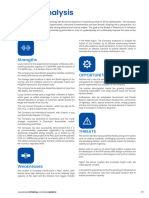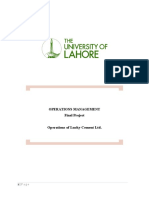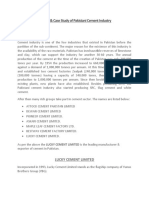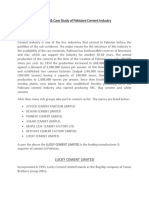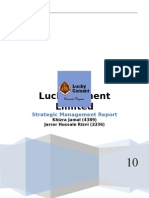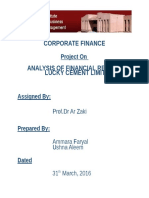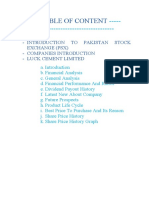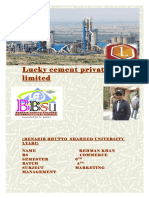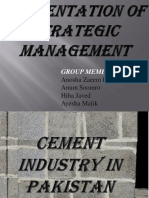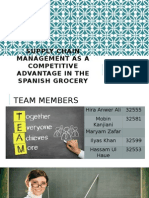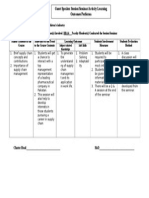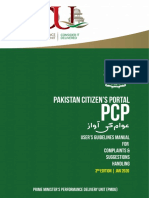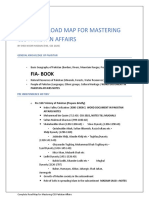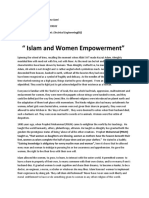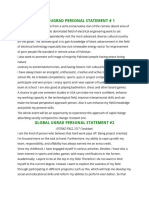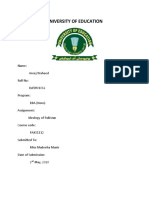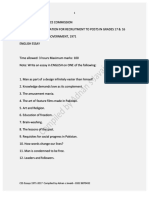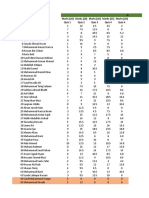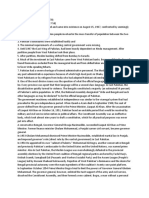1.
INTRODUCTION OF LUCKY CEMENT
Founded by late Chairman Mr. RazzakTabba, Younus Brothers
Group - one of the largest export houses in Pakistan.
First plant was built in 1996 in Pezu, and LakkiMarwat, and it had
a capacity of 4200 tons/day. As on now, the plants in Karachi
and Pezu are rated amongst the best plants in Asia, and they
have a capacity of 24,000 tons/day.
According to the CEO, Muhammed Ali Tabba, the biggest
advantage of having a plant in Karachi is that you stay close to
the largest cement market of the country, and take advantage
of the positioning and availability of the product.
Lucky cement is the youngest amongst its competitors, the
largest cement manufacturer, and the largest exporter of
cement in Pakistan.
The company is listed on Karachi, Lahore, Islamabad and London
Stock Exchanges.
1.1
MISSION
Our Mission is to be a premium cement manufacturer by building
a professional organization, having state-of-the-art technology,
identifying new prospects to reach globally and maintain service
and quality standards To Carter to the international construction
needs with an environment-friendly approach
Page | 1
�1.2
VISION
We envision being the leader of the cement industry in
Pakistan, Identifying and capitalizing on new opportunities in
the global market contributing
towards industrial progress and sustainable future, while being
responsible corporate citizens.
2. PRODUCT LINE
Product Line for lucky cement is dividing into 6
integrated cement products which are as under
Page | 2
�3.
COMPETITORS
Page | 3
�Out of 24 companies in the cement
sectors market, 4 of them hold the
majority market share:
Lucky Cement- 20%
DG Khan cement- 15%
Bestway cement- 11%
Maple Leaf cement-10%
Page | 4
�3.1
STATEMENT OF
PRODUCTION CAPACITY OF
CEMENT IN PAKISTAN
Lucky Cement has 16.19% of the total cements output
capacity of Pakistan SOURCE: APCMA
Page | 5
�3.2
EXPORT CONTRIBUTION TO
SALES
Lucky Cement, the biggest exporter with exports accounting for 38% of
total sales
Source: tribune.com.pk (2014)
Page | 6
�4.
INDUSTRY TRENDS
CEMENT INDUSTRY IN PAKISTAN
Domestic cement sales are up 9% year-over-year for the first 7
months of Pakistan's Fiscal 2014-15.
The Domestic demand for cement rose by 6 %, but the
international demand for Pakistani cement had fallen.
Market capitalization of Pakistani cement companies
has jumped 70% last year, about 3 times more than the
KSE-100 market index which rose 27% in 2014. This is the
third consecutive year that cement companies have
outperformed the broader market.
Investors in Pakistan's cement sector have seen 600% rise in
the last three years.
Forecasts
With expected GDP annual growth to average 4.5-5.5% over the next
3 years, local cement sales could rise by 9 % on average annually to
reach 34 million tons per year by 2017 and exports to 8 million tons
per year.
The reason for the rise in the local cement demand is
the falling inflation, the lowering of the interest rates,
and the falling of the oil prices.
Page | 7
�5. DIRECTORS REPORT
5.1
o
Financial Performance
LCL has recorded the highest ever profit after tax of Rs.
11.344 billion (up by 16.4%), reason being: unmatched
efficiency and low cost of production.
o The cost of production has also increased by 6.1% during
2013-14, mainly due to increase in gas tariff and rise in prices
of packaging material. This was also reflected in Lucky
Cements gross margin ratio, which fell by 0.9%
Other financial performance indicators (Rs.):
Revenue: 43.083 billion
Gross profit: 18.690 billion
Operating profit: 14.548 billion
EBITDA: 16.621 billion
Page | 8
� Net profit: 11.344 billion
5.2
Business Prospects
5.2.1 Projects
Waste Heat Recovery (WHR) Plants at Captive
Power Plants
For a 5 MW WHR plant to be installed at the Karachi captive
power plant, civil and existing structure modification work
is in progress and the plant and machinery is expected to
be installed by the end of the calendar year 2014. For
another 5 MW WHR plant to be installed at Pezu captive
power plant, the order for the plant and machinery has
already been placed whereas the civil and mechanical work
is expected to start soon at the plant site and plant and
machinery is expected to be installed by the end of
financial year 2015.
Vertical Grinding Mills at Karachi Plant
Page | 9
�Two state-of-the-art vertical grinding mills to be
installed at the Karachi Plant have already been
received at the plant site. Civil and local fabrication work
has been completed, whereas erection work at plant site is
in progress. The first mill will become operational by the
end of October 2014, whereas the second will become
operational by the end of December 2014.
TDF Plant at Pezu
Company had planned to introduce Tyre Derived Fuel (TDF)
plant at Pezu to replace coal. Since the coal prices in the
international market have come down compared to what
prevailed last year and are fairly stable, therefore, your
Company has decided to defer the investment in this
project.
Electricity Supply to PESCO
Your Company has secured an approval for power
generation from NEPRA for the supply of surplus electricity
from its Pezu power plant to the Peshawar Electric Supply
Company (PESCO). Your Company is currently in the
process of negotiation with PESCO
5.2.2 Investments
Investment in 660MW coal based power plant
Page | 10
�Lucky
Cement
Limited
has
resolved
to
recommend to its shareholders to invest in
setting up a 660MW Coal Based Power project in Karachi
through its subsidiary M/s Lucky Holdings Limited (LHL) in
which the Company holds 75% shares.
The CEO and the Board has recommended for the approval
of the shareholders, an equity investment of approximately
PKR 20 billion (US$ 200.0 million approximately) for the
above referred project to be set up by a newly
Formed entity by the name of Lucky Electric Power
Company Limited (LEPCL). LEPCL will be a wholly owned
subsidiary of LHL and a 75% indirect subsidiary of Lucky
Cement.
Joint Venture Investment in NYA, a Cement Plant
in DR Congo
Furthering its aim of international expansion, Lucky Cement
is setting up a joint venture cement manufacturing plant in
Congo, named
NyumbaYaAkiba. Contract for Plant and Machinery of NYA
has been signed with European equipment supplier
FLSmidth and down payment as per the terms and
conditions of the contract has been released to secure
timely delivery of Plant and Machinery. Project is expected
to start by June 2016
Equity Investment in Associated Company in 50
MW Wind Farm
Page | 11
�The EPC Contractors have been mobilized at site
for the preliminary works and financial close with
the consortium of local banks for project financing is
expected to be achieved by the end of October 2014. The
project is expected to be completed by January 2016.
Joint Venture Investment in Cement Grinding
Facility in Iraq
Al Mabrooka Cement, the joint venture grinding mill in Iraq
started commercial production in February 2014. During
the first five months operations up to June 2014, the
grinding mill achieved cement production of 142,500 tons
and sales volumes of 135,000 tons. Sales have picked up
considerably since June 2014 and plant is expected to
maintain production at 70% - 80% of the capacity over the
next financial year
Page | 12
�5.3
Risks
5.3.1 Business Risks
The primary risk of Lucky cement is that there is no switching
cost to the customer because all the cement companies, due
to severe competition, supply more or less the same quality
of cement with more or less the similar price. The Company
is also exposed to foreign currency exchange rates and
interest rates volatility.
Lucky cement has recognized the followings as threats to its
operations:
Law and order situation of Pakistan
Rising input cost of materials.
Rising input cost of energy.
Rising cost of logistics.
Currency risk.
New entrant threats due to high potential market size.
Page | 13
�The management of Lucky Cement has identified several risks and
provided the strategies its employing to mitigate those risks.
Risks
Employee Risk
Mitigation Strategies
Commitment towards professional
development and training
Employees are given proper compensation
and benefits
Following employment opportunity program
Risk of Increase in Cost of
Raw Material/ Costof
production
Senior management is involved in the pricing
of the product and is monitored on a regular
basis.
Costs are controlled internally as much as
possible.
To ensure profitability, the Company is
diversifying into different markets of the
world.
Safety and Security Risk
Organized session and training on Basic Life
Support
Training for firefighting and drills in case of
fire causalities
Availability of fire extinguishers and safety
helmets are ensured at both the Pants and
the Head Office.
Operational Risk
Timely and regular maintenance and
examination of plant machinery, operations
and administrative function is carried out in
order to mitigate Operational Risk.
Exchange Rate Risk
Exchange Rate Risk is mitigated due to
proportionate balance between import and
export transactions.
Interest Rate Risk
Economic Indicators are monitored in order
to better understand the interest rate trend
and the senior management makes
Page | 14
�decisions and strategies
accordingly.
Compliance/Legal Risk
Environmental Risk
The Company has departments looking after
the legal and compliance requirements. The
Internal Audit/ Compliance and Legal
Departments ensure that the Company does
not face any Compliance/Legal Risk.
TDF (Tyre Derived Fuel) Plant is set up to
reduce the carbon emission.
RDF (Refused Derived Fuel) Plant is also
installed to reduce environmental
degradation
WHR (Waste Heat Recovery) plant has been
set up which uses the heat generated from
the production to generate electricity
Political and Economic Risk
Both Plants are operational almost
throughout the year, despite the political
crises
The Senior Management ensures that the
plant remains operational and production is
not curtailed
5.3.2 Financial Risks
Lucky Cement is completely Debt free and has no leverages.
The company has improved its liquidity significantly and its
capital reserve has increased by 23.2% to Rs.46.6 billion
5.4
Unusual events / Contingency
There has been no such events highlighted by Lucky Cement
management in their report
Page | 15
�6.
ANALYSIS OF AUDIT REPORT
The Audit for the fiscal year 2014had been conducted by Ernst and
Young Ford Rhodes SidatHyder. In the Audit Report provided to the
members, we have found that the Auditor has given a qualified
opinion because of the inconsistent accounting policies adopted by
Lucky Cement. The accounting policies in question were;
1. Standards, interpretations, amendment to approved accounting
standards that became effective.
2. Estimation of Staff Retirement Benefits
7.
References
http://tribune.com.pk/story/623283/manufacturers-asked-to-search-fornew-markets-to-stay-competitive /
http://www.apcma.com/data_productioncapacity.html
http://www.slideshare.net/aliamjad42/analysis-on-the-cement-industry-inpakistan
http://pakobserver.net/detailnews.asp?id=135399
Page | 16
�TABLE CONTENT
S#
1.
Content
Pg.
3.2 Export Contribution to Sales
1
1
1
2
3
4
5
4.
Industry Trends
Directors Report
5.1Financial Performance
5.2Business Prospects
5.2.1Projects
5.2.2 Investment
Introduction of Lucky Cement
1.1 Mission
1.2 Vision
2.
3.
Product Line
Competitors
3.1 Statement of Production Capacity
5.3 Risk
11
5.3.1 Business Risk
12
5.3.2 Financial Risk
13
5.4Unusual Event / Contingency
13
6.
Analysis of Audit Report
14
7.
References
14
Page | 17
�Page | 18












